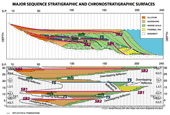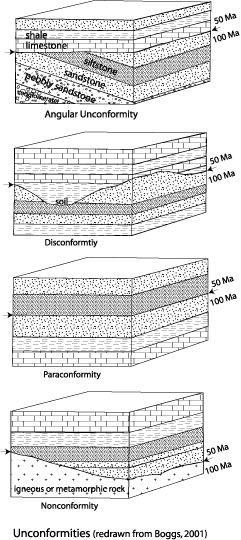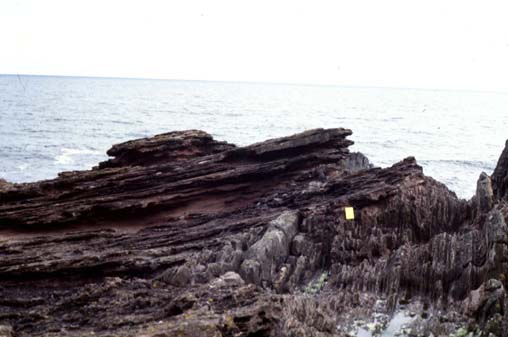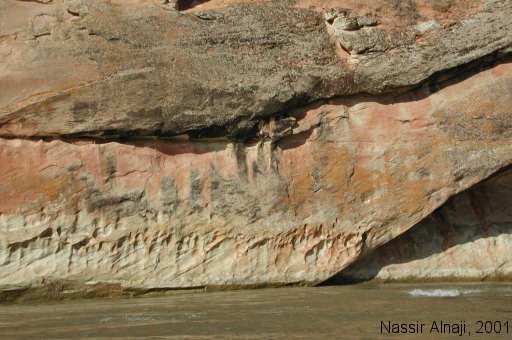|
correlative conformity
forced regression
hiatus
sequence
sequence boundary
type 1 sequence boundary
type 2 sequence boundary



|
A surface of erosion or non-deposition separating younger strata from older rocks, along which there is evidence of subaerial erosional truncation (and, in some areas, correlative submarine erosion) or subaerial exposure, with a significant hiatus indicated. Exxon group modified this definition to "a surface separating younger from older strata, along which there is evidence of subaerial erosional truncation (and, in some areas, correlative submarine erosion) or subaerial exposure, with a significant hiatus indicated" or downdip correlative conformities marking a hiatus in sedimentation (Vail, et al., 1977). Catuneanu (2002) and Hunt and Tucker (1992) suggest the correlative conformity forms on the paleo-sea floor at the end of forced regression and correlates with the seaward termination of the subaerial unconformity. Catuneanu (2006) indicates that the subaerial unconformity is synonymous with the lowstand unconformity (Schlager, 1992); the regressive surface of fluvial erosion (Plint and Nummedal, 2000); fluvial entrenchment/incision surface (Galloway, 2004). He sees the surface as the result of fluvial erosion or bypass, pedogenesis, wind degradation and related to the stages of base-level fall in the standard sequence stratigraphic models; stages of transgression (e.g., Leckie, 1994); and climate-driven stages of increased fluvial discharge (e.g., Blum, 1994).
 |
Angular conformity: younger sediments rest upon the eroded surface of tilted or folded older rocks.
|
|
Disconformity: contact between younger and older beds is marked by a visible, irregular or uneven erosional surface.
|
|
Paraconformity: beds above and below the unconformity are parallel and no erosional surface is evident; but can be recognized based on the gap in the rock record.
|
|
Nonconformity: develops between sedimentary rock and older igneous or metamorphic rock that has been exposed to erosion.
|

Angular unconformity at Siccar Point in Scotland.Yellow notebook
for scale. Photo Geoscience Group (GG) St Andrews University.
It was at SiccarPoint that James Hutton was heard to remark (ca. 1786) on the enormity of geological time, "...that we find no vestige of a beginning, no prospect of an end..." (James Hutton (1795) Theory of the Earth).
See the startling YouTube video posted by the British Geological Survey with a narrated description of the “Great Unconformity". View this and capture a moment in the history stratigraphic geology when Hutton and Playford visited and saw Sicca Point for the first time.

disconformity exposed in the cliffed bank of the San Juan River, Paradox basin, Southeastern Utah.
References
Blum, M.D., (1994), Genesis and architecture of incised valley fill sequences: a late Quaternary example from the Colorado River, Gulf coastal plain of Texas. In: Weimer, P., Posamentier, H.W. (Eds.), Siliciclastic sequence stratigraphy: Recent Developments and Applications, vol. 58. American Association of Petroleum Geologists Memoir, pp. 259–283.
Catuneanu, Octavian (2002), Sequence Stratigraphy of clastic systems: concepts, merits, and pitfalls Journal of African Earth Sciences, Volume 35, Issue 1, Pages 1-43.
Catuneanu, Octavian (2006), Principles of sequence stratigraphy, Elsevier pp 375
Galloway, W.E.,( 2004), accommodation and the sequence stratigraphic paradigm. Reservoir, Canadian Society of Petroleum Geologists, v. 31, Issue 5, p. 9-10.
Hunt, D., and M. E. Tucker, 1992, Stranded parasequences and the forced regressive wedge systems tract: deposition during base-level fall, Sedimentary Geology, 81, 1-9.
Leckie, D.A., (1994), Canterbury Plains, New Zealand––Implications for sequence stratigraphic models. American Association of Petroleum Geologists Bulletin 78, 1240–1256.
Plint, A.G., Nummedal, D.,( 2000), The falling stage systems tract: recognition and importance in sequence stratigraphic analysis. In: Hunt, D., Gawthorpe, R.L. (Eds.), Sedimentary Response to forced regression, vol. 172. Geol. Soc. London Speci. Publ, pp. 1–17.
Schlager, W., (1992), Sedimentology and sequence stratigraphy of Reefs and carbonate Platforms: A Short Course: Tulsa, The American Association of Petroleum Geologists, 71 p.
Vail, P. R. , R. G. Todd,and J. B. Sangree, (1977), Seismic stratigraphy and Global Changes of Sea Level: Part 5. Chronostratigraphic Significance of Seismic Reflections: Section 2. Application of Seismic Reflection Configuration to Stratigraphic Interpretation Memoir 26, Pages 99 – 116.
|